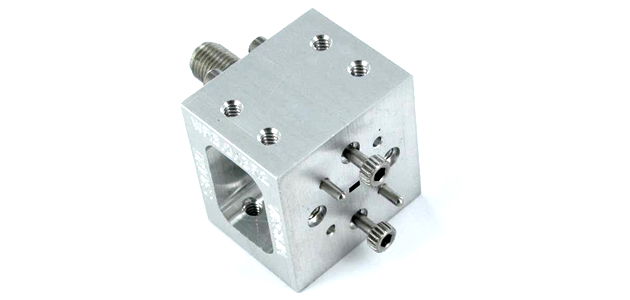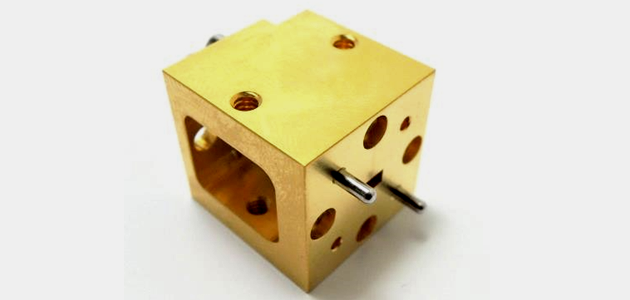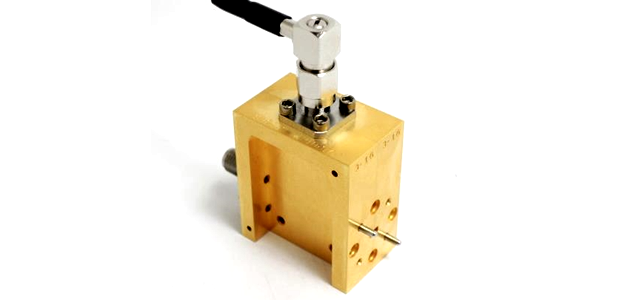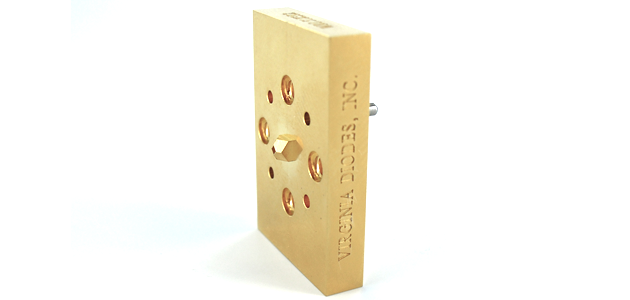



Frequency Multipliers (WR and D Series)
VDI offers a broad range of millimeter-wave varistor mode, passive frequency multipliers based on planar GaAs Schottky diode technology. Frequency doublers and triplers are used to extend the frequency coverage of microwave and millimeter-wave sources.
VDI broadband doublers and triplers have high efficiency (up to ~4%) across full waveguide bands. VDI offers broadband frequency doublers from WR-15 (50-75 GHz) to WR-1.9 (400-600 GHz). VDI offers broadband frequency triplers from WR-15 (50-75 GHz) to WR-0.34 (2200-3300 GHz).
VDI high power doublers offer high efficiency (up to ~40%) across a narrowband (~5-10% fractional 3 dB bandwidth). VDI offers high power doublers from ~50 GHz to ~500 GHz. High power doublers can be optimized for specific applications.
| Frequency (GHz) | WR | Wide-Band Doublers (x2) | Wide-Band Triplers (x3) |
| 50-75 | WR-15 | WR15x2 | WR15x3 |
| 60-90 | WR-12 | WR12x2 | WR12x3 |
| 75-110 | WR-10 | WR10x2 | WR10x3 |
| 82-125 | WR-9.0 | WR9.0x3 | |
| 90-140 | WR-8 | WR8.0x2 | WR8.0x3 |
| 110-170 | WR-6.5 | WR6.5×2 | WR6.5×3 |
| 140-220 | WR-5.1 | WR5.1×2 | WR5.1×3 |
| 170-260 | WR-4.3 | WR4.3×2 | WR4.3×3 |
| 220-330 | WR-3.4 | WR3.4×2 | WR3.4×3 |
| 260-400 | WR-2.8 | WR2.8×2 | WR2.8×3 |
| 330-500 | WR-2.2 | WR2.2×2 | WR2.2×3 |
| 400-600 | WR-1.9 | WR1.9×2 | WR1.9×3 |
| 500-750 | WR-1.5 | WR1.5×3 | |
| 600-900 | WR-1.2 | WR1.2×3 | |
| 750-1100 | WR-1.0 | WR1.0x3 | |
| 1100-1700 | WR-0.65 | WR0.65×3 | |
| 1400-2200 | WR-0.51 | WR0.51×3 |
See WR for additional details on waveguide band designations.
Contact VDI today for additional information.
| Specifications for Varactor Doublers* | ||||||
| VDI Part # | RF Output Frequency (GHz)† | Peak Efficiency (%)†† | Typical 3dB | RF Input
| Output Flange | Input Flange |
| D48 | 42 – 52 | 33 | 14 | 300 – 2250 | WR-19 UG-383/U | 2.9mm(f) |
| D52-W | 48 – 57 | 25 | 14 | 300 – 1950 | WR-19 UG-383/U | 2.9mm(f) |
| D52-N | 48 – 58 | 32 | 8 | 300 – 1950 | WR-19 UG-383/U | 2.9mm(f) |
| D58 | 48 – 65 | 32 | 14 | 450 – 1800 | WR-15 UG-385/U | 2.9mm(f) |
| D62 | 51 – 67 | 33 | 14 | 400 – 1800 | WR-15 UG-385/U | 2.9mm(f) |
| D72 | 64 – 79 | 28 – 30 | 14 | 400 – 1500 | WR-12 UG-387/U | 2.9mm(f) |
| D84 | 73 – 90 | 28 – 30 | 14 | 250 – 1000 | WR-10 UG-387/U-M | WR-22 UG-383/U |
| D90 | 86 – 96 | 30 | 10 | 200 – 900 | WR-10 UG-387/U-M | WR-19 UG-383/U |
| D102 | 92 – 109 | 27 | 14 | 200 – 700 | WR-10 UG-387/U-M | WR-19 UG-383/U |
| D108 | 92 – 124 | 30 | 10 | 250 – 1000 | WR-8.0 UG-387/U-M | WR-15 UG-385/U |
| D110 | 104 – 118 | 25 – 30 | 8 | 200 – 900 | WR-8.0 UG-387/U-M | WR-15 UG-385/U |
| D123 | 110 – 132 | 24 – 28 | 8 | 150 – 700 | WR-6.5 UG-387/U-M | WR-15 UG-385/U |
| D153 | 135 – 157 | 24 – 28 | 8 | 150 – 650 | WR-6.5 UG-387/U-M | WR-12 UG-387/U |
| D175 | 157 – 192 | 25 – 30 | 8 | 120 – 550 | WR-5.1 UG-387/U-M | WR-10 UG-387/U-M |
| D210 | 195 – 228 | 25 | 8 | 100 – 500 | WR-4.3 UG-387/U-M | WR-8.0 UG-387/U-M |
| D252 | 225 – 278 | 20 – 25 | 7 | 100 – 450 | WR-3.4 UG-387/U-M | WR-6.5 UG-387/U-M |
| D315 | 280 – 338 | 18 – 23 | 6.5 | 120 – 220 | WR-2.8 UG-387/U-M | WR-5.1 UG-387/U-M |
| D330 | 280 – 340 | 20 – 25 | 10 | 20 – 190 | WR-2.8 UG-387/U-M | WR-5.1 UG-387/U-M |
| D370 | 330 – 420 | 18 | 6 | 15 – 110 | WR-2.2 UG-387/U-M | WR-4.3 UG-387/U-M |
| D450 | 400 – 470 | 13 | 6 | 30 – 120 | WR-2.2 UG-387/U-M | WR-4.3 UG-387/U-M |
| D530 | 440 – 590 | 9 – 13 | 5 | 10 – 80 | WR-1.9 UG-387/U-M | WR-3.4 UG-387/U-M |
| D650 | 580 – 680 | 9 – 13 | 5 | 8 – 75 | WM-380 UG-387/U-M | WR-3.4 UG-387/U-M |
and maximum 3dB bandwidth limits of the multiplier respectively.
††The multiplier can be configured to operate at an RF input power level within the wide RF input power range specified above. However, the
multiplier is expected to operate approximately ±1dB centered around the RF input power level specified, not exceeding the maximum or
minimum RF input power range listed above. Different biases may be required to achieve optimal performance across the full input power range
specified above. Efficiency and 3dB bandwidth may be reduced at low RF input power levels.
RF Input Power Damage Limit is expected to be approximately +2dB above the specified RF input power level specified, not exceeding
the maximum RF input power listed above. See individualized datasheet for damage limit.
*This table is not a comprehensive list of all the varactor multipliers VDI offers. VDI may offer a different multiplier that is better suited for your
application.
| Specifications for Varactor Triplers* | ||||||
| VDI Part # | RF Output Frequency (GHz)† | Peak Efficiency (%)†† | Typical 3dB | RF Input
| Output Flange | Input Flange |
| T93 | 89 – 97 | 17 – 20 | 5 | 35 – 185 | WR-10 UG-387/U-M | 2.9mm(f) |
| T108 | 103 – 110 | 12 – 15 | 5 | 35 – 185 | WR-8.0 UG-387/U-M | 2.9mm(f) |
| T220 | 208 – 225 | 10 – 13 | 5 | 50 – 150 | WR-4.0 UG-387/U-M | WR-12.8 UG-387/U-M |
| T228 | 223 – 233 | 10 – 12 | 5 | 75 – 170 | WR-4.3 UG-387/U-M | WR-12.2 UG-387/U-M |
| T282 | 276 – 290 | 8 – 10 | 4 | 75 – 140 | WR-3.4 UG-387/U-M | WR-10 UG-387/U-M |
| T321 | 305 – 335 | 7 – 9 | 4 | 20 – 55 | WR-2.8 UG-387/U-M | WR-8.0 UG-387/U-M |
| T438 | 432 – 444 | 8 – 9 | 4 | 15 – 55 | WR-2.0 UG-387/U-M | WR-6.5 UG-387/U-M |
†The RF Output Frequency range indicates the range over which the multiplier can be tuned. The lower and upper limits indicate the minimum
and maximum 3dB bandwidth limits of the multiplier respectively.
††The multiplier can be configured to operate at an RF input power level within the wide RF input power range specified above. However, the
multiplier is expected to operate approximately ±1dB centered around the RF input power level specified, not exceeding the maximum
or minimum RF input power range listed above. Different biases may be required to achieve optimal performance across the full input power range
specified above. Efficiency and 3dB bandwidth may be reduced at low RF input power levels.
RF Input Power Damage Limit is expected to be approximately +2dB above the specified RF input power level specified, not exceeding
the maximum RF input power listed above. See individualized datasheet for damage limit.
*This table is not a comprehensive list of all the varactor multipliers VDI offers. VDI may offer a different multiplier that is better suited for your
application.
Product Manuals and Specifications